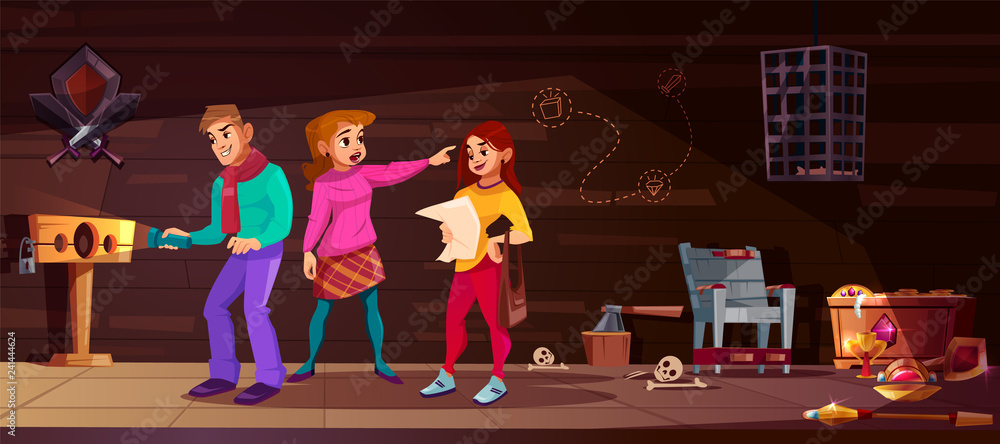Virtual escape rooms have transformed from a niche entertainment option into a global phenomenon, offering immersive puzzle-solving experiences accessible from anywhere in the world. Whether you’re a team leader seeking innovative activities, a gaming enthusiast, or simply curious about this digital evolution, this comprehensive guide explores everything you need to know about virtual escape rooms.
What Are Virtual Escape Rooms?
Virtual escape rooms are interactive online experiences where participants solve sudoku puzzles, decode mysteries, and complete challenges to “escape” from a digital environment within a set time limit. Unlike traditional escape rooms that require physical presence, these digital adventures unfold on computers, tablets, smartphones, or VR headsets.
The experience leverages cutting-edge technology including virtual reality (VR), augmented reality (AR), sophisticated graphics engines, and real-time collaboration tools to create environments that rival—and sometimes surpass—the immersion of physical spaces. Players connect remotely, communicate through voice or video chat, and work together as a unified team despite geographical distances.
The Perfect Storm: Why Virtual Escape Rooms Exploded in Popularity
The COVID-19 pandemic acted as a catalyst for virtual escape rooms, accelerating a trend that was already gaining momentum. When lockdowns closed physical escape room venues worldwide in 2020, businesses and entertainment seekers turned to digital alternatives. What began as a temporary solution revealed lasting benefits: the convenience of playing from home, the ability to include friends and family across continents, and the elimination of travel time and costs.
However, the appeal extends far beyond pandemic necessity. Virtual escape rooms address fundamental challenges of modern life—connecting dispersed teams, providing meaningful entertainment that engages the mind, and offering shared experiences in an increasingly digital world.
Key Takeaways
- Universal Accessibility: Virtual escape rooms eliminate geographical barriers, allowing anyone with an internet connection to participate
- Technological Innovation: Advanced VR, AR, and interactive technologies create deeply immersive experiences
- Team Building Powerhouse: These experiences strengthen communication, collaboration, and problem-solving skills
- Endless Variety: Themes range from historical mysteries to sci-fi adventures, with customization options for different audiences
- Growing Industry: The market continues expanding with new features, platforms, and integration with other entertainment forms
- Challenges Remain: Technical issues, design complexity, and market saturation present ongoing obstacles
Understanding Virtual Escape Rooms
Core Concept and Mechanics
At their heart, virtual escape rooms transform the beloved escape room formula into a digital format accessible to anyone, anywhere. These aren’t simple video games—they’re sophisticated interactive experiences designed to replicate and enhance the tension, excitement, and collaborative problem-solving of physical escape rooms.
The typical experience involves:
Pre-Game Setup: Teams assemble online, receive their mission briefing, and learn the control systems for their specific platform.
Immersive Environment: Players enter richly detailed digital spaces—from haunted Victorian mansions to futuristic space stations—each crafted with meticulous attention to atmosphere and storytelling.
Collaborative Puzzle-Solving: Participants must communicate effectively, sharing observations and theories as they uncover clues hidden throughout the virtual environment.
Progressive Challenges: Puzzles typically build in complexity, requiring teams to apply logic, pattern recognition, lateral thinking, and teamwork.
Time Pressure: Most rooms incorporate countdown timers, adding urgency and excitement to the experience.
Victory or Defeat: Teams either successfully “escape” by solving all puzzles before time expires or discuss what stumped them and learn from the experience.
Essential Features and Technologies
Modern virtual escape rooms incorporate several technological innovations:
3D Environments and Graphics: Advanced rendering engines create photorealistic spaces with dynamic lighting, weather effects, and interactive objects that respond to player actions.
Virtual Reality Integration: VR headsets transport players directly into the escape room environment, allowing them to physically reach out, grab objects, and examine clues from all angles.
Augmented Reality Elements: AR technology overlays digital information onto real-world spaces, blending physical and virtual gameplay in innovative ways.
Real-Time Communication: Integrated voice and video chat ensures smooth collaboration without requiring external communication tools.
Cloud-Based Platforms: Server-side processing allows multiple players to interact with the same environment simultaneously, with actions visible to all participants instantly.
Adaptive Difficulty: Some platforms incorporate AI that adjusts puzzle difficulty based on team performance, ensuring appropriate challenge levels.
Progress Tracking: Systems monitor team advancement, providing hints when players get stuck and recording completion times for competitive leaderboards.
Virtual vs. Traditional Escape Rooms: A Comprehensive Comparison
| Aspect | Traditional Escape Rooms | Virtual Escape Rooms |
|---|---|---|
| Location | Requires physical venue visit | Accessible from anywhere with internet |
| Group Size | Limited by room capacity (typically 4-10) | Flexible, from 2 to 100+ participants |
| Cost | $25-40 per person average | $10-30 per person, often less for groups |
| Accessibility | Requires mobility, travel capability | Accessible for individuals with physical limitations |
| Environmental Flexibility | Fixed physical props and layouts | Easily changeable themes and environments |
| Tactile Experience | Physical interaction with props | Visual and auditory interaction |
| Technology Integration | Limited by physical constraints | Unlimited digital possibilities |
| Social Interaction | Face-to-face, high energy | Remote but still collaborative |
| Setup Time | Travel time plus check-in | Login and start within minutes |
Both formats offer unique advantages. Traditional escape rooms provide tactile satisfaction and face-to-face bonding, while virtual versions excel in accessibility, convenience, and technological innovation.
Historical Context and Popularity Surge
Origins of the Escape Room Concept
The escape room concept traces back to “escape the room” video games in the early 2000s, particularly Japanese point-and-click adventures. The first physical escape room opened in Kyoto, Japan in 2007, created by Takao Kato of the company SCRAP. The concept spread rapidly across Asia before reaching Europe and North America around 2012-2013.
By 2015, thousands of physical escape room venues operated worldwide, becoming a popular choice for corporate team building, birthday parties, and date nights. The industry was thriving, with many venues booking solid weeks in advance.
The Pandemic Pivot
When COVID-19 struck in early 2020, the escape room industry faced existential crisis. Physical venues closed overnight, and thousands of businesses faced bankruptcy. However, innovative operators quickly pivoted to virtual platforms, adapting their puzzles and narratives for online delivery.
What began as survival strategy revealed unexpected benefits. Companies discovered they could:
- Reach international audiences previously limited by geography
- Run multiple simultaneous sessions without room capacity constraints
- Update and modify puzzles more easily than physical props
- Lower operating costs significantly
- Offer experiences at more competitive price points
Post-Pandemic Growth
As restrictions eased, virtual escape rooms didn’t disappear—they evolved into a permanent industry segment. The market has continued growing as companies recognize several sustainable advantages:
Corporate Adoption: Businesses with remote and hybrid workforces have embraced virtual escape rooms for team building, with some companies running monthly events.
Educational Integration: Schools and universities incorporate escape rooms into curricula, teaching critical thinking, collaboration, and subject-specific content through gamified experiences.
Entertainment Diversification: Virtual escape rooms now complement rather than compete with physical venues, with many companies offering both formats.
Technological Advancement: Continuous improvements in VR/AR technology, internet speeds, and gaming platforms make virtual experiences increasingly sophisticated.
Technological Advancements in Virtual Escape Rooms
Revolutionary VR and AR Applications
Virtual and augmented reality represent the cutting edge of escape room technology:
Fully Immersive VR Experiences: Platforms like Oculus Quest and HTC Vive enable players to step into entirely virtual worlds. You can physically walk around rooms (within play space boundaries), pick up and manipulate objects with hand controllers, and experience 360-degree environments with spatial audio that makes sounds come from specific directions.
Hand Tracking Technology: Advanced virtual reality systems now recognize hand gestures without controllers, allowing more natural interaction. Players can point, grab, and manipulate objects using intuitive movements.
Haptic Feedback: Sophisticated controllers provide tactile responses—vibrations, resistance, and texture simulation—that enhance immersion when interacting with virtual objects.
Mixed Reality Experiences: AR platforms overlay digital clues and puzzles onto physical spaces. Players might search their actual rooms for virtual hidden objects or see digital characters appear in their living room through tablet screens.
Multiplayer VR Spaces: Multiple players can inhabit the same virtual room simultaneously, seeing avatar representations of teammates and collaborating in shared three-dimensional space.
Social Media and Community Integration
Modern virtual escape rooms leverage social connectivity:
Live Streaming Integration: Players can broadcast their attempts on Twitch or YouTube, building community and providing entertainment for viewers.
Leaderboard Competition: Global and friend-group leaderboards add competitive elements, encouraging replay to improve times.
Social Sharing Features: Automatic screenshot capture, achievement unlocking, and sharable completion certificates encourage social media sharing.
Friend Invitations: Seamless systems allow players to invite contacts directly through social platforms or email.
Community Puzzle Creation: Some platforms enable users to design and share their own escape rooms, fostering creative communities.
Emerging Technology Trends
The future holds exciting technological possibilities:
AI-Driven Narratives: Artificial intelligence will create dynamic storylines that adapt based on player choices, providing unique experiences for each team.
Biometric Integration: Future systems might monitor heart rate, stress levels, and emotional responses to adjust intensity and provide personalized challenges.
Blockchain-Based Unique Puzzles: Cryptographic technology could create truly unique, one-time-solvable puzzles that can never be exactly replicated.
Advanced Natural Language Processing: Voice-controlled interfaces will allow players to verbally interrogate virtual characters or give spoken commands to interact with environments.
Holographic Displays: Emerging holographic technology may enable glasses-free 3D projections, eliminating the need for headsets while maintaining immersion.
5G Network Enhancement: Ultra-fast connectivity will enable more complex multi-player interactions with zero lag, supporting larger teams and more detailed environments.
Benefits of Virtual Escape Rooms

Unmatched Accessibility and Convenience
Virtual escape rooms democratize access to entertainment:
Geographical Freedom: A team in New York can play alongside colleagues in Tokyo and London simultaneously, impossible with physical venues.
Disability Accommodation: Individuals with mobility challenges, visual impairments (with proper accessibility features), or other conditions can participate fully where physical rooms might present barriers.
Scheduling Flexibility: Many platforms offer 24/7 availability, accommodating different time zones and busy schedules without venue hour restrictions.
No Travel Requirements: Eliminate commute time, parking hassles, and associated costs. Start playing within minutes of deciding to participate.
Comfort and Safety: Play in familiar surroundings with chosen refreshments, comfortable seating, and personal bathroom access.
Weather Independent: Never cancel plans due to storms, snow, or extreme temperatures affecting travel.
Powerful Team Building and Collaboration
Virtual escape rooms offer exceptional developmental benefits:
Communication Skills: Teams must articulate observations clearly, listen actively, and share information efficiently under time pressure.
Leadership Emergence: Natural leaders often surface as teams organize approaches to complex challenges.
Problem-Solving Practice: Participants develop analytical thinking, pattern recognition, and creative solution generation.
Trust Building: Relying on teammates to complete tasks fosters mutual trust and confidence.
Remote Team Bonding: Particularly valuable for distributed workforces, providing shared experiences that build camaraderie despite physical separation.
Conflict Resolution: Teams navigate disagreements about puzzle solutions, practicing diplomatic communication and compromise.
Cross-Cultural Collaboration: International teams gain experience working across cultural and communication style differences.
Many corporations report improved team cohesion, communication, and morale following regular virtual escape room sessions. The investment typically pays dividends in increased productivity and reduced workplace friction.
Extraordinary Variety and Customization
The digital format enables unprecedented diversity:
Unlimited Themes: From historical mysteries (solve crimes in ancient Egypt) to horror experiences (escape zombie outbreaks), science fiction adventures (repair a failing spaceship), fantasy quests (retrieve magical artifacts), and everything in between.
Difficulty Scaling: Most platforms offer multiple difficulty levels, ensuring appropriate challenges for beginners through expert puzzle solvers.
Educational Content: Custom rooms can teach specific subjects—history, science, mathematics, language skills—through engaging gameplay.
Brand Integration: Companies commission custom rooms featuring their products, training materials, or company history for onboarding and education.
Age Appropriateness: Family-friendly versions ensure content suitable for children, while adult-oriented rooms can explore mature themes.
Seasonal Specials: Holiday-themed rooms (Halloween horrors, Christmas mysteries) provide timely entertainment.
Cultural Customization: Rooms can be localized with language translations, cultural references, and region-specific themes.
Cost-Effectiveness
Virtual escape rooms typically cost less than physical alternatives:
- Lower operational overhead for providers translates to reduced player costs
- No travel expenses for participants
- Ability to play with larger groups without per-person price multiplication
- Subscription models offer unlimited play for flat monthly fees
- Corporate bulk pricing makes team building more affordable
Challenges and Limitations
Technical Issues and User Experience Obstacles
Despite advances, technology can still frustrate:
Internet Connectivity Requirements: Slow or unstable connections cause lag, freezing, or disconnections that disrupt immersion and waste precious time.
Hardware Limitations: Older computers or mobile devices may struggle with graphics-intensive environments, resulting in poor frame rates or crashes.
Software Compatibility: Different operating systems, browsers, and devices sometimes experience compatibility issues that prevent proper loading.
Learning Curve: VR headsets and complex interfaces require orientation time, potentially overwhelming less tech-savvy participants.
Audio/Video Quality: Poor microphone or camera quality hampers communication, while echo and feedback issues create frustration.
Platform Glitches: Bugs in puzzle logic, unresponsive clickable areas, or progression blockers require game developers intervention.
VR Motion Sickness: Some individuals experience nausea, disorientation, or headaches from VR experiences, limiting participation.
Best Practices for Mitigation:
- Test technology and connections before scheduled game time
- Ensure all participants have necessary software updates installed
- Provide technical support contacts for troubleshooting
- Offer non-VR alternatives for motion-sensitive individuals
- Start with tutorial levels to familiarize players with controls
Design Complexity and Balance
Creating engaging virtual escape rooms presents significant challenges:
Puzzle Difficulty Balance: Too easy becomes boring; too difficult frustrates. Designers must calibrate precisely for target audiences.
Intuitive Navigation: Virtual environments can be disorienting. Poor spatial design leaves players lost and confused rather than challenged.
Hint System Implementation: Providing appropriate assistance without spoiling solutions requires sophisticated design.
Story Integration: Puzzles must feel narratively justified rather than arbitrarily placed obstacles.
Replayability Considerations: Once solved, escape rooms lose mystery. Designers struggle to create experiences worth revisiting.
Production Quality: High expectations for graphics, voice acting, music, and overall polish require substantial investment.
Accessibility Features: Designing for various ability levels, language speakers, and technical proficiencies adds complexity.
Market Saturation and Differentiation
As the industry matures, standing out becomes increasingly difficult:
Crowded Marketplace: Hundreds of providers compete for attention, making discovery challenging for consumers.
Quality Variation: With low barriers to entry, the market includes both exceptional experiences and poorly executed attempts.
Price Competition: Aggressive pricing by some providers pressures margins across the industry.
Innovation Pressure: Audiences quickly acclimate to features that once seemed novel, demanding constant innovation.
Marketing Challenges: Reaching target audiences amid digital advertising noise requires substantial marketing budgets.
Review Dependence: New entrants struggle to compete with established providers who have extensive positive reviews.
Copycat Concerns: Popular puzzle concepts and themes get replicated, reducing uniqueness.
Case Studies: Successful Virtual Escape Rooms

The Alcatraz Escape
This prison-break themed experience became one of the most popular virtual escape rooms during 2020-2021. Players work to escape from the notorious island prison, solving puzzles related to actual Alcatraz history. Success factors included:
- Meticulous historical research creating authentic atmosphere
- Balanced difficulty progression keeping players challenged but not frustrated
- Exceptional production values with professional voice acting and period-appropriate graphics
- Educational content teaching genuine Alcatraz history alongside entertainment
The experience achieved over 50,000 successful completions within its first year and maintains a 4.8/5 average rating across review platforms.
Prison Breakout VR
This fully immersive VR experience places players inside a maximum-security prison cell with one goal: escape before the warden’s morning rounds. Notable achievements:
- Pioneering use of hand-tracking technology for intuitive object manipulation
- Dynamic difficulty adjustment based on player performance
- Multiplayer coordination requiring simultaneous actions from different cell blocks
- Corporate adoption by major companies for team-building exercises
The experience generated substantial revenue while demonstrating VR’s potential for collaborative gameplay.
Educational Success: The Codebreaker Chronicles
Designed specifically for classroom use, this series of escape rooms teaches mathematics, history, and critical thinking to students aged 10-14. Impact includes:
- Adoption by over 2,000 schools across 15 countries
- Measurable improvement in student engagement with difficult subjects
- Positive feedback from educators regarding retention and understanding
- Awards for innovative educational technology
Impact on Local and Global Markets
The impact of successful virtual escape rooms extends beyond individual success; they influence both local and global markets. As these experiences gain popularity, they contribute to a growing interest in virtual entertainment options, driving innovation and competition in the industry.
Feedback and User Reviews
User feedback has been overwhelmingly positive, highlighting the immersive nature and the quality of the puzzles. Many reviews emphasize the fun and challenging aspects of the games, particularly noting how they enhance teamwork and collaboration. This feedback is crucial for developers to refine and improve their offerings, ensuring a continually engaging experience for users.
The Future of Virtual Escape Rooms
Predictions and Trends
The trajectory of virtual escape rooms is marked by bold innovations in technology that promise to enhance the immersive experience. As the line between reality and virtuality blurs, these rooms are expected to become more sophisticated and engaging. The integration of advanced VR and AR technologies will continue to revolutionize the puzzle-driven escape room industry, offering experiences that are not only entertaining but also artistically profound.
Potential for Growth in New Markets
The global appeal of virtual escape rooms is expanding, with significant growth potential in markets previously untapped. As these experiences become more accessible and culturally adaptable, new demographics across different regions are showing increased interest. This expansion is supported by the scalability of virtual platforms, allowing for rapid deployment and customization to meet diverse cultural expectations.
Integration with Other Entertainment Forms
Virtual escape rooms are increasingly being integrated with other forms of entertainment, such as video games, movies, and even educational platforms. This convergence creates a multifaceted entertainment experience that attracts a broader audience. By combining elements from various entertainment sectors, virtual escape rooms can offer a richer and more varied experience, appealing to users who seek dynamic and interactive forms of leisure.
All in All
As we’ve explored the dynamic and engaging world of virtual escape rooms, it’s clear that they represent a significant evolution in the realm of interactive entertainment. The rise of virtual escape rooms has not only provided a viable alternative to traditional physical escape rooms but has also expanded the accessibility and appeal of this form of entertainment to a broader audience. With their unique ability to connect people from various locations in immersive adventures, virtual escape rooms continue to grow in popularity, offering an exciting blend of challenge, teamwork, and fun. As technology advances, we can only expect these virtual experiences to become even more captivating and widespread, ensuring that the thrill of escape rooms can be enjoyed by everyone, anywhere.
Frequently Asked Questions
What is a virtual escape room?
A virtual escape room is an online platform that replicates the experience of a traditional escape room, allowing participants to solve puzzles and overcome challenges in a virtual environment from the comfort of their own homes.
How do virtual escape rooms differ from traditional ones?
Unlike traditional escape rooms that require physical presence, virtual escape rooms are accessible remotely via the internet. They often incorporate advanced technology such as VR and AR to enhance the immersive experience.
What are the key benefits of participating in a virtual escape room?
Virtual escape rooms offer convenience, accessibility, and a wide range of themes and difficulty levels. They promote teamwork and problem-solving skills in a fun and engaging setting.
Can virtual escape rooms be customized for different groups?
Yes, many virtual escape room providers offer customizable experiences tailored to the specific needs and preferences of different groups, making them ideal for team-building events, educational purposes, or personal entertainment.
What technological advancements are enhancing virtual escape rooms?
Recent advancements include the use of Virtual Reality (VR) and Augmented Reality (AR), which provide deeper immersion and a more realistic experience. Integration with social media and other online platforms also enhances interactivity and accessibility.
What challenges do virtual escape rooms face?
Challenges include technical issues, maintaining user engagement over virtual platforms, designing complex puzzles that are both challenging and enjoyable, and navigating market saturation with innovative offerings.








